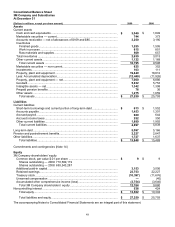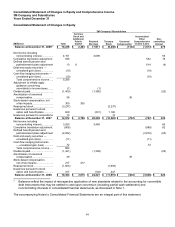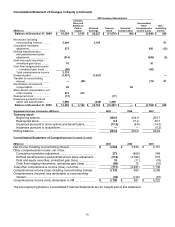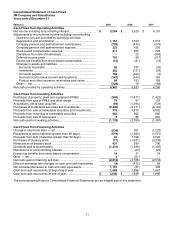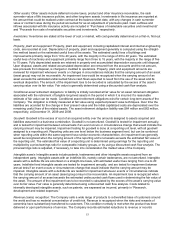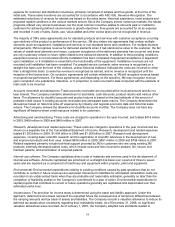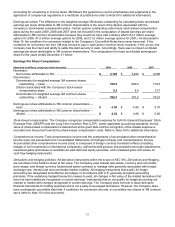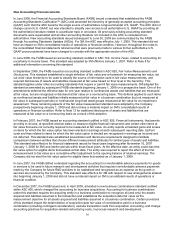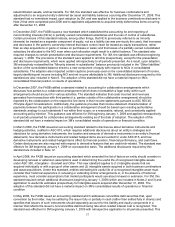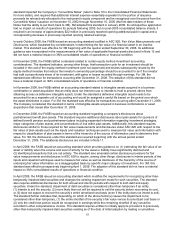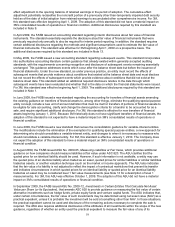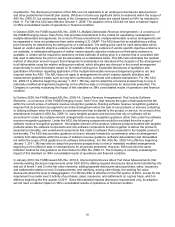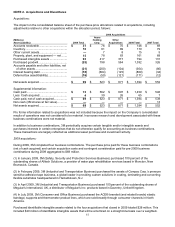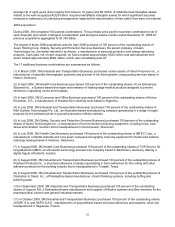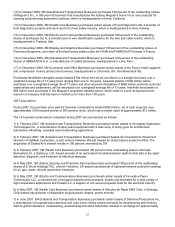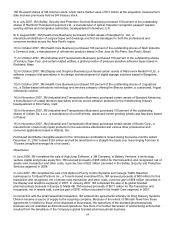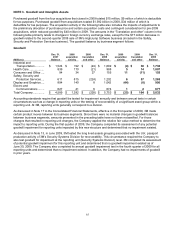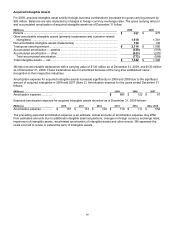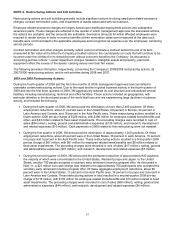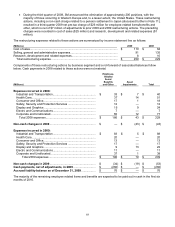3M 2009 Annual Report Download - page 64
Download and view the complete annual report
Please find page 64 of the 2009 3M annual report below. You can navigate through the pages in the report by either clicking on the pages listed below, or by using the keyword search tool below to find specific information within the annual report. 58
standard impacted the Company’s “Convertible Notes” (refer to Note 10 to the Consolidated Financial Statements
for more detail), and required that additional interest expense essentially equivalent to the portion of issuance
proceeds be retroactively allocated to the instrument’s equity component and be recognized over the period from the
Convertible Notes’ issuance on November 15, 2002 through November 15, 2005 (the first date holders of these
Notes had the ability to put them back to 3M). 3M adopted this standard in January 2009. Its retrospective application
had no impact on results of operations for periods following 2005, but on post-2005 consolidated balance sheets, it
resulted in an increase of approximately $22 million in previously reported opening additional paid in capital and a
corresponding decrease in previously reported opening retained earnings.
In early October 2008, the FASB issued an accounting standard codified in ASC 820, Fair Value Measurements and
Disclosures, which illustrated key considerations in determining the fair value of a financial asset in an inactive
market. This standard was effective for 3M beginning with the quarter ended September 30, 2008. Its additional
guidance was incorporated in the measurements of fair value of applicable financial assets disclosed in Note 13 and
did not have a material impact on 3M’s consolidated results of operations or financial condition.
In November 2008, the FASB ratified a standard related to certain equity method investment accounting
considerations. The standard indicates, among other things, that transaction costs for an investment should be
included in the cost of the equity-method investment (and not expensed) and shares subsequently issued by the
equity-method investee that reduce the investor’s ownership percentage should be accounted for as if the investor
had sold a proportionate share of its investment, with gains or losses recorded through earnings. For 3M, the
standard was effective for transactions occurring after December 31, 2008. The adoption of this standard did not
have a material impact on 3M’s consolidated results of operations or financial condition.
In November 2008, the FASB ratified an accounting standard related to intangible assets acquired in a business
combination or asset acquisition that an entity does not intend to use or intends to hold to prevent others from
obtaining access (a defensive intangible asset). Under the standard a defensive intangible asset needs to be
accounted for as a separate unit of accounting and would be assigned a useful life based on the period over which
the asset diminishes in value. For 3M, the standard was effective for transactions occurring after December 31, 2008.
The Company considered this standard in terms of intangible assets acquired in business combinations or asset
acquisitions that closed after December 31, 2008.
In December 2008, the FASB issued an accounting standard regarding a company’s disclosures about
postretirement benefit plan assets. This standard requires additional disclosures about plan assets for sponsors of
defined benefit pension and postretirement plans including expanded information regarding investment strategies,
major categories of plan assets, and concentrations of risk within plan assets. Additionally, this standard requires
disclosures similar to those required for fair value measurements and disclosures under ASC 820 with respect to the
fair value of plan assets such as the inputs and valuation techniques used to measure fair value and information with
respect to classification of plan assets in terms of the hierarchy of the source of information used to determine their
value. For 3M, the disclosures under this standard are required beginning with the annual period ended
December 31, 2009. The additional disclosures are included in Note 11.
In April 2009, the FASB issued an accounting standard which provides guidance on (1) estimating the fair value of an
asset or liability when the volume and level of activity for the asset or liability have significantly declined and
(2) identifying transactions that are not orderly. The standard also amended certain disclosure provisions for fair
value measurements and disclosures in ASC 820 to require, among other things, disclosures in interim periods of the
inputs and valuation techniques used to measure fair value as well as disclosure of the hierarchy of the source of
underlying fair value information on a disaggregated basis by specific major category of investment. For 3M, this
standard was effective prospectively beginning April 1, 2009. The adoption of this standard did not have a material
impact on 3M’s consolidated results of operations or financial condition.
In April 2009, the FASB issued an accounting standard which modifies the requirements for recognizing other-than-
temporarily impaired debt securities and changes the existing impairment model for such securities. The standard
also requires additional disclosures for both annual and interim periods with respect to both debt and equity
securities. Under the standard, impairment of debt securities is considered other-than-temporary if an entity
(1) intends to sell the security, (2) more likely than not will be required to sell the security before recovering its cost,
or (3) does not expect to recover the security’s entire amortized cost basis (even if the entity does not intend to sell).
The standard further indicates that, depending on which of the above factor(s) causes the impairment to be
considered other-than-temporary, (1) the entire shortfall of the security’s fair value versus its amortized cost basis or
(2) only the credit loss portion would be recognized in earnings while the remaining shortfall (if any) would be
recorded in other comprehensive income. The standard requires entities to initially apply its provisions to previously
other-than-temporarily impaired debt securities existing as of the date of initial adoption by making a cumulative-


